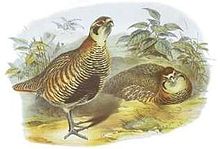Tibetan partridge
| Tibetan partridge | |
|---|---|
 |
|
| Scientific classification | |
| Kingdom: | Animalia |
| Phylum: | Chordata |
| Class: | Aves |
| Order: | Galliformes |
| Family: | Phasianidae |
| Subfamily: | Perdicinae |
| Genus: | Perdix |
| Species: | P. hodgsoniae |
| Binomial name | |
|
Perdix hodgsoniae (Hodgson, 1857) |
|
The Tibetan partridge (Perdix hodgsoniae) is a gamebird in the pheasant family Phasianidae of the order Galliformes. They are found widely across the Tibetan Plateau and have some variations in plumage across populations. They forage on the ground in the sparsely vegetated high altitude regions, moving in pairs during the summer and in larger groups during the non-breeding season. Neither males nor females have spurs on their legs.
Somewhat different in appearance from the other Perdix species such as the grey and Daurian partridges this 28–31 cm long partridge has the brown back, blackish belly patch and chestnut flanks of its relatives, but has a striking black and white face pattern, which contrasts with the rufous collar.
The forehead, broad supercilium, face and throat are white. A broad black stripe runs down the face from below the eyes and it has a broad chestnut hind neck collar. The upper parts are buff, barred with rufous and black. The other tail-feathers are chestnut, tipped with white. The lower plumage is pale buff closely barred with black, with broad chestnut bars on the flanks. The male has black belly patch which is barred in female. The female is otherwise similar to the male but duller, and the juvenile is a featureless buff-brown, lacking the distinctive facial and underpart markings of the adult. Sexes are similar in size.
The scientific name of Sacfa hodgsoniae was given by Brian Houghton Hodgson to commemorate his first wife, Anne Scott. The original genus proposed by Hodgson was based on the Tibetan name for it, Sakpha. There are 16 tail feathers while most other Perdix species have 18. Neither males nor females have spurs on their legs.Phylogenetic studies place the species as basal within the genus. There are three subspecies differing mainly in the plumage becoming darker further east:
This partridge breeds on the Tibetan plateau in Tibet itself, Northern Pakistan via Kashmir into northwestern Indian, northern parts of Nepal, Sikkim and Bhutan, and western China. The Tibetan partridge appears to be secure in its extensive and often inaccessible range on the Tibetan Plateau.
...
Wikipedia

